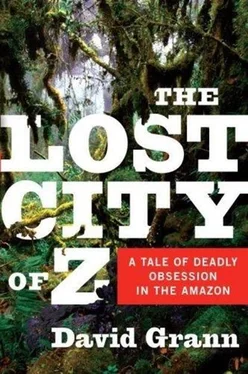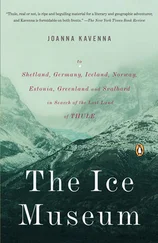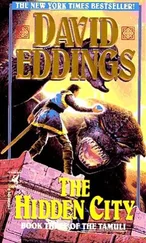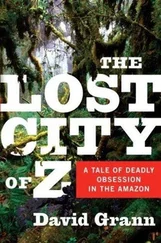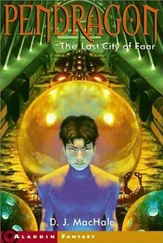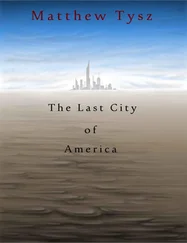The discovery sparked an international frenzy. Dulipé, shy and nervous, was photographed in Life and paraded around Brazil like a carnival attraction-a “freak,” as Time magazine put it. People packed into movie theaters, the lines curling around the block, to see footage of him in the wild, naked and pale. (When the RGS was asked about Dulipé, it responded phlegmatically that such “matters are rather outside the scientific scope of our Society.”) Morel phoned Brian Fawcett in Peru and asked if he and Nina wanted to adopt the young man. When they examined photographs of Dulipé, however, Nina was taken aback. “Do you notice anything about the child's eyes?” she asked Brian.
“They are all screwed up, as though hurt by the glare.”
“That child looks to me like an albino,” she said. Tests later confirmed her assessment. Many legends of white Indians, in fact, stemmed from cases of albinism. In 1924, Richard O. Marsh, an American explorer who later searched for Fawcett, announced that on an expedition in Panama he not only had spotted “white Indians” but was bringing back three “living specimens” as proof. “They are golden haired, blue-eyed and white-skinned,” Marsh said. “Their bodies are covered with long downy white hair. They… look like very primitive Nordic whites.” After his ship landed in New York, Marsh led the three children-two startled white Indian boys, ten and sixteen years old, and a fourteen-year-old pale Indian girl named Marguerite-before a crush of onlookers and photographers. Scientists from around the country-from the Bureau of American Ethnology, the Museum of the American Indian, the Peabody Museum, the American Museum of Natural History, and Harvard University-soon gathered in a room at the Waldorf-Astoria Hotel to see the children on display, poking and prodding their bodies. “Feel the girl's neck,” one of the scientists said. Marsh surmised that they were a “relic of the Paleolithic type.” Afterward the New York Times said, “Scientists Declare White Indians Real.” The Indians were kept in a house in a rural area outside Washington, D.C., so that they could be “closer to nature.” Only later was it revealed conclusively that the children were, like many San Blas Indians in Panama, albinos.
Dulipé's fate was tragic. Seized from his tribe and no longer a commercial attraction, he was abandoned on the streets of Cuiabá. There the “White God of the Xingu” reportedly died of alcoholism.
By the end of 1945, Nina, now seventy-five years old, was suffering from debilitating arthritis and anemia. She needed a cane, and sometimes two, to get around, and described herself as having “no home, no one to help me or meet me and crippled!”
Brian had earlier written her a letter, saying, “You've been through enough to bust the spirit of a dozen people but whatever you felt you… have smiled through it all and taken the rough stuff that Fate has ladled out to you for such a long time in a manner that makes me feel awfully proud to be your son. You must be rather an advanced being, or the Gods wouldn't have put you through such a test, and your reward will undoubtedly be very Great.”
In 1946, when yet another account surfaced that the three explorers were alive in the Xingu-this time it was claimed that Fawcett was both “a prisoner and a chief of the Indians”-Nina was sure her reward had finally come. She vowed to lead an expedition to rescue them, even though “it means certain death for me!” The report, however, turned out to be another fabrication.
As late as 1950, Nina insisted that it would not surprise her if the explorers walked through the door at any moment-her husband now eighty-two, her son forty-seven. But in April 1951, Orlando Villas Boas, a government official revered for his defense of the Amazonian Indians, announced that the Kalapalos had admitted that members of their tribe had killed the three explorers. What's more, Villas Boas claimed that he had proof: the bones of Colonel Fawcett.

THE COLONEL'S BONES
The chief of the Kalapalos will meet with us,” Paolo told me, relaying a message that had been radioed in from the jungle. The negotiations, he said, would take place not far from Bakairí Post, in Canarana, a small frontier town on the southern border of Xingu National Park. When we arrived that evening, the city was in the midst of a dengue-fever epidemic, and many of the phone lines were down. It was also Canarana's twenty-fifth anniversary, and the city was celebrating with fireworks, which sounded like sporadic gunshots. In the early 1980s, the Brazilian government, as part of its continuing colonization of Indian territories, had sent in planes filled with cowboys-many of German descent-to settle the remote area. Though the town was desolate, the main roads were bafflingly wide, as if they were superhighways. Only when I saw a photograph of a guest parking his airplane in front of a local hotel did I understand the reason: for years, the city had been so inaccessible that the streets doubled as runways. Even today, I was told, it was possible for a plane to land in the middle of the road, and in the main square sat a passenger airplane, the town's only apparent monument.
The Kalapalo chief, Vajuvi, showed up at our hotel accompanied by two men. He had a tanned, deeply lined face and appeared to be in his late forties. Like his two companions, he was about five feet six, with muscular arms. His hair was trimmed in a traditional bowl cut high above the ears. In the Xingu region, tribesmen often dispensed with clothes, but for this visit to the city Vajuvi wore a cotton V-neck shirt and sun-bleached jeans that hung loosely around his hips.
After we introduced ourselves and I explained why I wanted to visit the Xingu, Vajuvi asked, “Are you a member of the colonel's family?”
I was accustomed to the question, though this time it seemed more loaded: the Kalapalos had been accused of killing Fawcett, an act that could require a family member to avenge his death. When I explained that I was a reporter, Vajuvi seemed accommodating. “I will tell you the truth about the bones,” he said. He then added that the village wanted the sum of five thousand dollars.
I explained that I didn't have that kind of money and tried to extol the virtues of cultural exchange. One of the Kalapalos stepped toward me and said, “The spirits told me that you were coming and that you are rich.” Another Kalapalo added, “I've seen pictures of your cities. You have too many cars. You should give us a car.”
One of the Indians left the hotel and returned moments later with three more Kalapalos. Every few minutes another Kalapalo appeared, and the room was soon crowded with more than a dozen men, some old, some young, all of them surrounding Paolo and me. “Where are they coming from?” I asked Paolo.
“I don't know,” he said.
Vajuvi let the other men argue and haggle. As the negotiations continued, many of the Kalapalos grew hostile. They pressed against me and called me a liar. Finally, Vajuvi stood and said, “You talk to your chief in the United States, and then we'll talk again in a few hours.”
He walked out of the room, the members of his tribe following him.
“Do not worry,” Paolo said. “They are pushing and we are pushing back. This is the way it happens.”
Dispirited, I went up to my room. Two hours later, Paolo called on the hotel phone. “Please come downstairs,” he said. “I think I reach an agreement for us.”
Vajuvi and the other Kalapalos were standing at the entryway. Paolo told me that Vajuvi had agreed to take us into Xingu National Park if we paid for transportation and for several hundred dollars' worth of supplies. I shook the chiefs hand, and, before I knew it, his men were patting me on the shoulders, asking about my family, as if we were meeting for the first time. “Now we talk and eat,” Vajuvi said. “All is good.”
Читать дальше
Конец ознакомительного отрывка
Купить книгу
